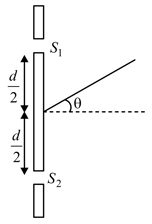HARD
12th West Bengal Board
IMPORTANT
Earn 100
In a Young's double slit experiment, the separation between the two slits is d and the wavelength of the light is . The intensity of light falling on slit is four times the intensity of light falling on slit . Choose the correct choice (s).
(a)If , the screen will contain only one maximum
(b)If at least one more maximum (besides the central maximum) will be observed on the screen.
(c)If the intensity talling on slit is reduced so that it becomes equal to that of slit , the intensities of the observed dark and bright fringes will increase
(d)If the intensity of light falling on slit is increased so that it becomes equal to that of slit , the intensities of the observed of the dark and bright fringes will increases.
(e)Both (i) and (ii)
50% studentsanswered this correctly

Important Questions on Wave Optics
HARD
12th West Bengal Board
IMPORTANT
HARD
12th West Bengal Board
IMPORTANT
HARD
12th West Bengal Board
IMPORTANT
In an interference arrangement similar to Young's double slit experiment, the slit and are illuminated with coherent microwave sources, each of frequency . The sources are synchronised to have zero phase-difference. The slits are separated by a distance The intensity is measured as a function of , where is shown . If is the maximum intensity, then for is given by

HARD
12th West Bengal Board
IMPORTANT
MEDIUM
12th West Bengal Board
IMPORTANT
EASY
12th West Bengal Board
IMPORTANT
EASY
12th West Bengal Board
IMPORTANT
MEDIUM
12th West Bengal Board
IMPORTANT
